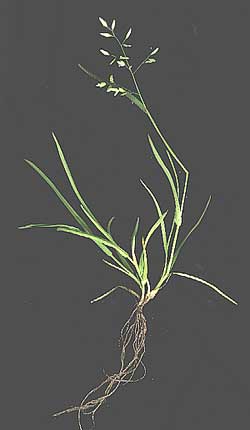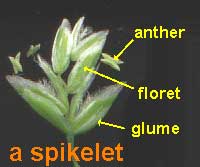Excerpts from Jim Conrad's
Naturalist Newsletter
from the March 21, 2004 Newsletter, issued from near Natchez, Mississippi, USA
ANNUAL BLUEGRASS FLOWERING
In lawns, along roads, around the barn, and even here and there in the forest, especially on exposed bayou banks, nowadays you see flowering tufts of Annual Bluegrass, POA ANNUA. This is a small grass usually standing no more than two or three inches high (5- 7cm). You notice it now because its flower clusters are pale and silvery against the grass's emerald green. Below you see an entire Annual Bluegrass plant.


At the right you see the Annual Bluegrass's flowers.
The plant shown is a "wild type" Annual Bluegrass. Many strains of Annual Bluegrass are known, however, and some are perennials spreading by stolons, completely unlike our "wild type," which just lives for a year and has fibrous roots. Those stoloniferous perennials get a lot of attention because they can be mowed and made into neat lawns, and they make ideal putting surfaces in golf courses. Here I resist the urge to launch into a tirade about the chemical pollution and waste of water and land occasioned by golf courses...
One reason it makes sense that Annual Bluegrass is flowering now is that bluegrasses are "cool-season species" using C3 photosynthesis.
Well, in the Plant Kingdom there are two broad categories of plants, the cool-season and warm-season ones, named C3 or C4, respectively. The difference between C3 and C4 plants relates to the chemical pathway they employ during photosynthesis. Both C3 and C4 use light energy to manufacture sugar from water and carbon dioxide, but C3 photosynthesis is most efficient in cool, moist weather, while C4 is best when it's hot and dry. Most higher plants use the C3 pathway.
It makes sense that Annual Bluegrass is a cool-season C3 plant because it evolved in Europe where it's much cooler and moister than here. It also makes sense that it is flowering during our cool, moist spring instead of later when it's really hot. When the heat turns on, C3 grasses tend to die back while C4 grasses thrive.
One thing this means is that in town where lawns are mostly composed of cool-season C3 grasses such as bluegrass, an unconscionable amount of water will be needed to "keep the lawn green" when summer comes. If C4 grasses were used instead, the lawn would need much less watering. However, C4 grasses tend to be shaggier than C3 bluegrasses. Bermuda Grass is a hot-season C4 grass introduced from Africa but most people find it too unkempt for a lawn. The wonderful bluestems I've told you about earlier also are C4 grasses.